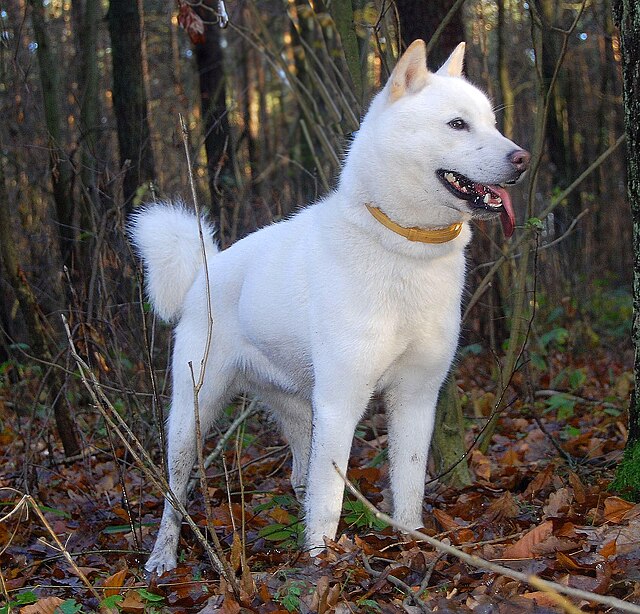


The Hokkaido Dog is a medium-sized Japanese breed known for its loyalty, courage, and versatility. As a member of the Spitz family, the Hokkaido Dog is admired for its rugged appearance, sharp senses, and strong hunting abilities. It was originally bred for hunting in the harsh climates of Japan’s Hokkaido island, where it is still highly regarded as a reliable and skilled working dog. The breed is well-suited for active families and owners who appreciate a dog with strong instincts and a protective nature.
The Hokkaido Dog, also known as the Ainu-ken, has a long history in Japan, dating back over 3,000 years. The breed was developed by the Ainu people, the indigenous inhabitants of Japan, to hunt large game such as bears, deer, and boars in the mountainous regions of Hokkaido. The Hokkaido was valued for its endurance, intelligence, and strong protective instincts. While the breed nearly faced extinction during the 20th century, dedicated preservation efforts have helped restore its numbers. In 1937, the Hokkaido Dog was designated as a National Monument of Japan due to its cultural and historical significance.
The Hokkaido Dog is a compact and muscular breed with a well-balanced, athletic build. It typically stands between 18 and 22 inches (46-56 cm) tall at the shoulder and weighs between 45 and 65 pounds (20-29 kg). The breed has a thick double coat designed to protect it from harsh weather conditions. The outer coat is straight and coarse, while the undercoat is soft and dense. Coat colors include red, black, brindle, and white. Its bushy tail curls over its back, and its ears are triangular and stand erect. The Hokkaido Dog has a strong, alert expression and is known for its sharp, keen eyes.
The Hokkaido Dog is known for its loyal, brave, and independent temperament. It is a calm and reserved dog, especially around strangers, but it forms deep bonds with its family and is protective of its home. While it is not overly aggressive, the Hokkaido has a strong guarding instinct and is a natural watchdog. It can be reserved or aloof with unfamiliar people but is affectionate and loving with its family members. The breed is generally good with children, although it may require proper training and supervision, especially with smaller children. The Hokkaido is intelligent, alert, and can be independent-minded, making it an excellent companion for experienced dog owners.
The Hokkaido Dog is an active and energetic breed that requires regular physical and mental exercise to stay healthy and content. Originally bred for hunting and working in harsh environments, it thrives when given a job to do. The breed enjoys outdoor activities such as hiking, running, and exploring, and it excels in activities like agility, obedience, and tracking. Daily walks, playtime in a securely fenced yard, and occasional off-leash adventures are necessary to keep the Hokkaido physically and mentally stimulated. Without sufficient exercise, it can become bored or develop behavioral problems.
Training the Hokkaido Dog can be both rewarding and challenging due to its independent and sometimes stubborn nature. While the breed is intelligent and capable of learning, it may not always be eager to follow commands unless motivated by clear leadership. Positive reinforcement methods, such as treats, praise, and play, work best. Early socialization is important to help the Hokkaido develop into a well-rounded dog, as it can be wary of strangers and other animals if not properly introduced. Early exposure to different environments, sounds, and people will help the Hokkaido become more adaptable and less territorial. Consistent, firm, and patient training is key to success with this breed.
The Hokkaido Dog is generally a healthy breed with few major health concerns. However, like all breeds, it can be prone to certain conditions such as hip dysplasia, hypothyroidism, and autoimmune disorders. Regular veterinary check-ups and maintaining a healthy diet are important to monitor for any potential health problems. The breed’s thick double coat requires regular grooming to keep it in good condition. Brushing at least once a week helps remove loose fur and prevents mats from forming. The Hokkaido’s ears should be checked and cleaned regularly to prevent infections, especially if the dog is exposed to wet conditions. Routine dental care is also recommended to maintain oral health.
The average lifespan of a Hokkaido Dog is between 12 and 15 years. With proper care, a healthy diet, regular exercise, and routine veterinary visits, the Hokkaido can live a long and active life. Maintaining good overall health is essential to ensuring that the breed remains fit and happy as it ages.
© copyright Dog Compendium 2024 - 2025